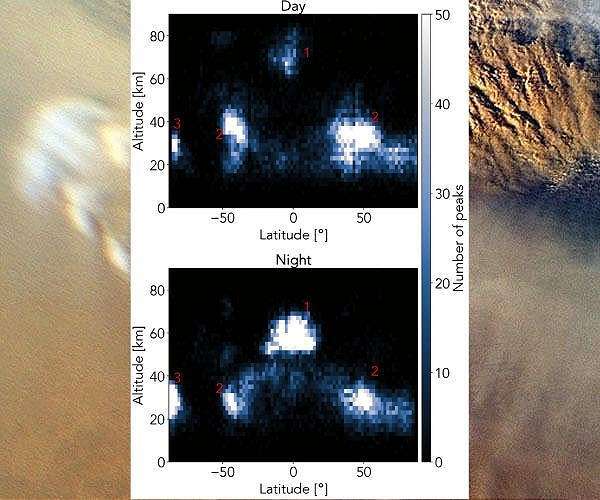6.11.2023

Volunteers found that clouds in Mars's atmosphere cluster at certain latitudes and altitudes. White patches in this pair of plots shows where Cloudspotting participants spotted the most clouds (or "arch peaks" in the project lingo). Red labels highlight a few interesting regions: 1) where high-altitude Carbon Dioxide-ice clouds form; 2) water-ice clouds that show a different pattern between day and night; and 3) clouds that form in a cold region over the poles.
In a groundbreaking collaborative effort, a new study drawing on the collective efforts of citizen scientists has shed light on the intricate patterns of Martian clouds. The research, fueled by contributions from the "Cloudspotting on Mars" project, has now reached a milestone with its acceptance for publication, soon to feature in a special Mars-focused issue of the esteemed journal Icarus.
The study in question is titled "The Cloudspotting on Mars citizen science project: Seasonal and spatial cloud distributions observed by the Mars Climate Sounder" and takes an in-depth look at data accumulated by the Mars Reconnaissance Orbiter (MRO). Specifically, it analyzes the findings from the Mars Climate Sounder instrument aboard the MRO, dedicated to scrutinizing the planet's atmospheric conditions.
Researchers, aided by volunteers, have meticulously mapped out numerous instances and locales of cloud formations, unveiling distinct cloud populations that enrich our understanding of the Martian atmosphere. These groups include towering clouds composed of carbon dioxide ice, formations prevalent near the Martian poles, and clouds that emerge during the dusty Martian seasons, comprised predominantly of water ice. The maps compiled from these findings illustrate a clear correlation with thermal tides - the rhythmic temperature oscillations on a global scale - suggesting that cooler atmospheric pockets are favored for cloud formation.
Delving into the methodology behind this citizen science endeavor, the paper outlines the project's origins and execution on the Zooniverse platform. It also explores the sophisticated application of machine learning to transform raw identifications by the project's participants into a refined cloud catalog.
Dr. Marek Slipski, the project's Principal Investigator from NASA's Jet Propulsion Laboratory, lauds the volunteers' pivotal role: "Thank you to all the Cloudspotting on Mars participants for driving this research forward!" His gratitude underscores the critical contribution of public involvement in advancing extraterrestrial meteorological research.
Despite these significant findings, the study suggests that the Martian atmosphere still holds many secrets. With only half of the data from the second Martian year analyzed, further scrutiny is essential to understand the impact of dust variability on cloud genesis fully.
For those with a keen interest in Martian atmospheric phenomena and who wish to contribute to this ongoing scientific quest, the project welcomes additional support. By analyzing more images and data, volunteers can help unravel the complexities of Martian meteorology. Interested individuals are encouraged to join the endeavor at the Cloudspotting on Mars website and contribute to this collective scientific venture.
This ongoing research not only epitomizes the power of citizen science in contributing to our understanding of other worlds but also serves as a beacon for future collaborative research efforts, reminding us of the untapped potential that resides in the collective curiosity and analytical power of enthusiastic volunteers.
Quelle: SD
